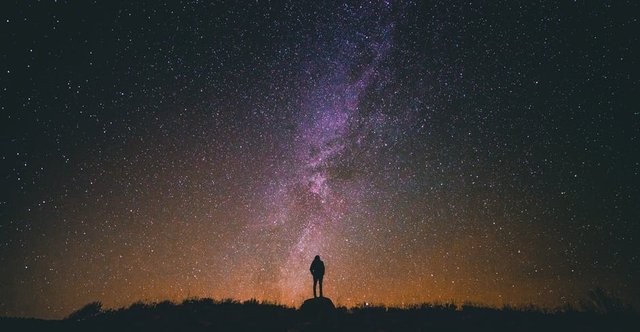What Does Astronomers and scientists Think About The Universe, Does It Have An End Or Not? Let's Find Out!
Hello steemit friends, do you know that the understanding we got about the universe today was based on the theory most astronomers that happens to be great scientist today formulated but checking out history, it's obvious that most of them if not all still do not understand what they see in the sky, the question now is "what's beyond the dark space", thinking of it as a box with surfaces enclosing it and we humans are living inside this box called universe. As a human, have you ever thought of what might be outside this box called universe "who knows if that's the place were heaven is located".

Many of these scientists came out with lots of theories about the universe with little or no degree of accuracy, with a geocentric view of this box called universe, making earth as a center of concentration. These theories actually gave us a little understanding of what the universe entails and little because I feel that there are more to that, knowing that our galaxy is but of millions child in the belly of the universe. I will love to give some few insight about some few achievement of most scientists from the early days of the world of Astronomy.
Science started communicating with changes around the 17th century and that was the year a man named Johannes Kepler postulated the law of planetary motion in both classical physics and astronomy, his law really helped in planetary understanding to describe the motion of planets in the solar system. With the help of Tycho Brahn, a Danish astronomer in the 16th century actually helped johonnes Kepler in his observation and this helped Kepler in his first two laws, which he later announced in 1609 and the third one he later made vivid to the world in the year 1618, although this nearly took him a decade.

Does the sun move? Kepler law was able to provide an answer to that;
Kepler's laws of planetary motion
●The path of the planets about the sun is elliptical in shape, with the center of the sun being located at one focus. (The Law of Ellipses) 2●An imaginary line drawn from the center of the sun to the center of the planet will sweep out equal areas in equal intervals of time. (The Law of Equal Areas) 3●The ratio of the squares of the periods of any two planets is equal to the ratio of the cubes of their average distances from the sun. (The Law of Harmonies)
From the law of gravitational force on bodies which sir isaac newton formulated, Kepler explanation from his first law that the planet motion round the sun was typically based on total energy of the planet to revolve in an elliptical orbit round the sun but the question to ask here is what if the planet tend to gain less energy, will it collapse to the sun or if the planet gain too much energy, will it tend to escape from the orbit(picture it as an electron in an orbit). He also went further in his observation from the second law of his planetary motion in the view of object's angular momentum and time period over a circular axis.
Outside the fact that this planetary laws help to improve human understanding about the universe, it also helped in the area of satellite, helping to unpower spacecraft and satellites going round the earth, not just having application in gravitate but also to other inverse square-law force which showed that the acceleration of gravity as an intensity expression. The third law didn't just got importance in understanding planets but very much found useful in studying the moons of planets. I will say during his staying on planet earth, this great man was able to calculate the relative size of the solar system but he didn't accomplish the calculation of the actual size, so you may ask what's the actual size of the earth?
| Mean diameter | 12,7418 km |
|---|---|
| Volume | 1.08×1012km3 |
| Density | 5.52g/cm3 |
| Circumference | 40,042 km |
| Surface area | 510,072,000 km2 |
| Mass | 5.974×1024kg |
Unluckily for him, he died on the 15th of November 1630, aging 58.

Before you think of anything at the moment, just imagine you throw a ball as fast as that of the speed of light and it gets to the surface edge of the universe, what will happen to the ball? scientists have proven that you eventually get to where you started because the universe was said to be isotropic, lots of scientists assume that the universe was infinite or finite with a surface edge. During the study of gravity by Sir Isaac newton, he concluded that the universe was indeed infinite because he felt that all the gravity would have collapse the universe by now if not infinite but albert einstein came along to say that the universe was static causing a cosmological constant to enable his math works but too bad, this wasn't correct for albert einstein.
Do you remember the movie called THE BIG BANG THEORY? but this isn't about the movie though it's actually about the THE BIG BANG THEORY which state that the universe was once super small and over years, the universe has been expanding to the way it is now, according to NASA which was after the big bang theory, you will most likely see ten billions degree of particles which includes electrons, protons and neutrons, everything expanded from particles came into agreement to come together and form atoms, this eventually gave birth to stars and galaxies( mmmn..).

In the Relation Between Distance And Radial Velocity Among Extra-Galactic Nebulae in 1929 by EDWIN HUBBLE, he found out that all the galaxies are flying away from us and that space is eventually expanding. The universe is said to be expanding in isotropic at 74.2 (plus or minus 3.6)km/smpc, basically galaxies moves 0.007% farther away from each other every millions years and this is how astronomers look at the universe, seeing it as a three dimensional region that expands in every direction in a four dimensional universe at once. So if you are thinking of going though the whole universe, you will still end up back where you initially started but is that posible?. With this claim, it is found that the universe got no center because the universe is expanding in isotropic, thanks to nature physics because more study are still being carried out.
So if the universe is still expanding, you may want to ask what's at the end of it?. The universe is ahead of us, expanding each moment you think and this as a result, we probably can't move fast enough to reach up, maybe one day scientists and astronomers we probably find out
Please drop a comment on the comment section, to let use know what you think about the end of the universe, till we meet and buzz around science again THANK YOU.
Reference
●Relation Between Distance And Radial Velocity Among Extra-Galactic Nebulae` in 1929 by EDWIN HUBBLE
●Kepler's Three Laws - The Physics Classroom

'My design'
Hi @stembuzz!
Your post was upvoted by utopian.io in cooperation with steemstem - supporting knowledge, innovation and technological advancement on the Steem Blockchain.
Contribute to Open Source with utopian.io
Learn how to contribute on our website and join the new open source economy.
Want to chat? Join the Utopian Community on Discord https://discord.gg/h52nFrV
I believe the universe will end just the way it started...the reverse process of big bang where it will go back to the point of singularity.